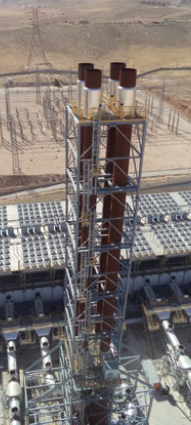 Conserve energy, reduce parasitic load, save money
Conserve energy, reduce parasitic load, save money
Challenge. Increasing the efficiency of the power station in a cost-effective manner is a continual goal of plant staff. Please see Amman East best practice for background.
Solutions and savings. Plant staff saw an opportunity to greatly reduce costs and house load through the application of a variety of energy conservation projects. After a thorough review of possible areas of implementation and cost-benefit analysis, the plant targeted the following areas to reduce the parasitic load:
- Engine-hall ventilation fans.
- Air management system.
- Lighting and HVAC timers and motion sensors.
- Electrical heat tracing system for residual oil.
- Feeder busbar changeover.
Engine hall ventilation fans. There are 80 fans inside the engine halls for ventilation purposes. Their operation depends on engine-hall temperature (turn on at 100F, off at 90F). Increasing the fan starting temperature to 110F (after OEM approval) saved $348,000 annually.
Air management system. Instrument air system used for balance-of-plant pneumatic controls relied on three compressors running continuously. Daily power consumption was around 1.2 MWh. By better controlling compressor start and stop times, daily power consumption was decreased by half, saving $38,000 annually.
Lighting and HVAC timers and motion sensors. Lighting and HVAC systems for plant buildings were running continuously. Building HVAC timers have been added to reduce A/C from 10 hr/day to 24. Plus, motion sensors have been installed to turn lights on and off as necessary. Annual savings: $15,000 from motion sensors, $25,000 from HVAC timers.
Electrical heat tracing is used for heating heavy fuel prior to engine start. Since shifting to gas, it is no longer needed. The heat-tracing logic circuit was modified to be ON when using oil, OFF on gas. Annual saving: $6000.
Feeder busbar changeover. Four medium-voltage busbars supply the low-voltage busbar to which plant auxiliaries are connected. Each MV busbar serves four engines. If fewer than four engines are started there is at least one MV busbar still importing power from the grid at about $178/MWh. A small modification was applied by changing the feeding busbar on the LV side at any MV busbar with no engines running, so it can be fed from the busbars of the running engines. Annual saving: $25,000.
Results. Implementation of these projects has reduced imported power requirements significantly, saving upwards of about $450,000 annually.
Project participants: Laith Jaraabeh, Erfan Ahamd, Ashraf Qasem, Ayman Mobaied, Wael Zghoul, Mohammad Aldabaibah
AES Levant Power Plant
AES Levant Holdings BV Jordan
250-MW, tri-fuel, peaking facility consisting of 16 diesel engines located in Al Manakher, Jordan
Plant manager: Meftaur Rahman



